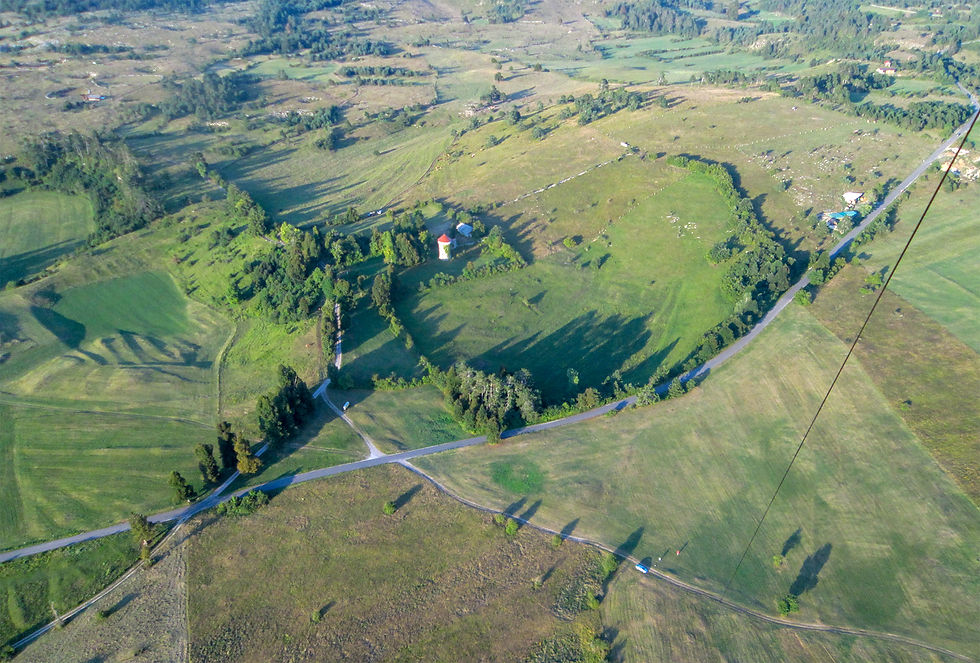Finding a Roman Camp
- kapjasa
- Sep 6, 2018
- 3 min read
Upper Pivka Valley is an archaeological treasure trove, with numerous Iron Age hillforts and settlements, with Roman villae, tradeposts and military camps, with medieval castles and old villages.
.
So when we saw those strange circles in kite aerial photos from our first visit to castle Kalec, excitement about a possible Iron Age roundhouse settlement was flying high as a kite.

Strange circles - how do they work? Read all about it here.
Surely, the experts expertly deflated our expectations (they even made a 3D model from our kite aerial photos!): those circles are (most probably) fairy rings, but other finds - old pottery shards - and topological features point to a Roman military camp or a trade post in the immediate vicinity.

Old pottery. Roman? Iron Age? Medieval?
And we went to the castle once again, bravely defying the omens - a threatening storm, a rogue Rokkaku breaking free and flying (with the camera still attached!) on its own across the Pivka valley, etc. - to give our archaeological instincts one more try.

Castle Kalec, its tower and remains of a walled enclosure. Somewhere in this picture a Roman camp - and maybe an Iron Age settlement - is hiding.
Apart from the beauty of this place and Pivka valley in general, we were looking for remains of old structures, their shadows visible in the setting sun... Is this mound a barrow? Are those lines perpendicular? And what is that?

Remains of ancient field partition are clearly visible. They used to farm here. But who?
Alas, no clear picture of a typical Roman camp, with its imaginative straight perpendicular lines, stood out. There are many barrows and mounds that could be something, but they must wait for the archaeologist's showel.

Lines, mounds and barrows in the landscape. Are they ....?
Even changing the moody Delta for the higher-flying Millie the french military kite did not help.

Delta is about to land while Mille is getting ready to fly. Caly the KAP dog supervises the delicate operation.
But as we were walking the kite up and down in order to capture as much as possible, we stepped upon a harvested field - and we went full archaeology. As we saw on TV, the archaeology field-walking often yield ancient finds: the plough turns the soil upside down and brings all the burried treasures to the surface. So we started to scan the ground - and the harvest was bountiful!
(Almost surely) Roman pottery, both fine and crude.
Two pieces of (iron) slag and an unidentified iron object.
Such plentiful pottery and slags indicate that there must be a settlement of some kind in the immediate vicinity. There were people cooking and eating there so long time ago, and they had a smelter, producing iron items and weapons and whatnot!
While it is pretty improbable these are Iron Age artefacts, and the Roman / Early Medieval verdict is still not out, the experts are leaning to place the finds into early Roman imperial era, 1st to 3rd century AD.
Well, no clear-cut huge discovery this - and most probably last - time at castle Kalec. However ...

What is that up there on the hill?

A road? A camp? A settlement? What?
... And so the story continues ... :-)

Many thanks to dr. Štular and dr. Lozic of ZRC SAZU, dr. Laharnar of National Museum of Slovenia, and dr. Gaspari of Department of Achaeology, Faculty of Arts, University of Ljubljana, for their time, kind advices, and their broad and deep expertise.
All kite aerial photos taken with Canon A810 on Great White Delta and Millie the French Military kites.






















Comments